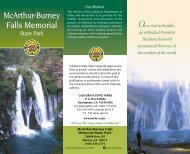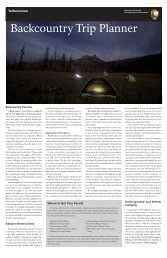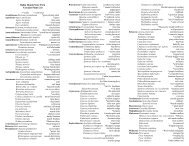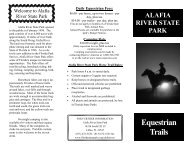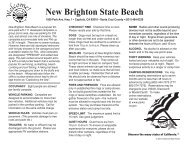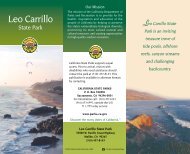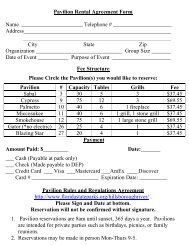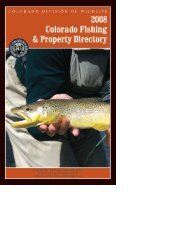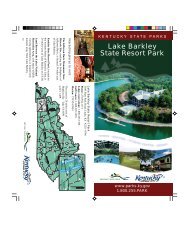You also want an ePaper? Increase the reach of your titles
YUMPU automatically turns print PDFs into web optimized ePapers that Google loves.
penniless in<br />
Kansas City. In<br />
a philanthropic<br />
gesture, Leland<br />
Stanford paid<br />
Marshall’s fare<br />
to New Jersey<br />
where he visited<br />
his mother and<br />
sister. After a<br />
few months,<br />
he returned<br />
to Kelsey and<br />
moved into the<br />
Union Hotel.<br />
In 1872 the<br />
State Legislature passed a bill to provide<br />
Marshall a pension of $200 a month<br />
for two years. He paid some debts and<br />
equipped a blacksmith shop in Kelsey.<br />
The state pension was reduced by half for<br />
the next four years, but it ended in 1878<br />
amid criticism of Marshall’s personal habits—especially<br />
his weakness for liquor.<br />
Marshall continued to work in his<br />
blacksmith shop and in the small gold<br />
mines he owned near Kelsey. When he<br />
died on August 10, 1885, at the age of<br />
75, the man who dug his grave on the<br />
hillside was Andrew Monroe, the son of<br />
Nancy Gooch. In 1890 a monumental<br />
statue—California’s first State Historic<br />
Monument—was commissioned and<br />
placed on the hill overlooking the gold<br />
discovery site to mark the location of<br />
Marshall’s grave.<br />
Photo by Ric Horner<br />
Cemetery and James Marshall’s cabin<br />
What if gold had not been<br />
discovered?<br />
California was a pastoral backwater<br />
and wilderness in 1848. Nine days<br />
after Marshall’s fateful discovery—at<br />
the conclusion of the Mexican-<br />
American War—the United States<br />
had been granted this land as<br />
part of a treaty. Its non-Indian<br />
population was about 14,000. At the<br />
time, only a few hundred overland<br />
pioneers had found ways to bring<br />
their wagon trains across the deserts<br />
and mountains to California. But<br />
that all changed with the discovery<br />
of gold.<br />
Between 1848 and 1852, the world’s fascination<br />
with California caused its non-Indian<br />
population to boom to more than 200,000.<br />
Few “Forty-Niners” intended to remain in<br />
California permanently—most had come to<br />
seek their fortune and then<br />
return home. But many sent<br />
for their families and stayed,<br />
while others returned later to<br />
become permanent residents.<br />
Over the next 50 years,<br />
roughly 125 million ounces of<br />
gold taken from the hills had<br />
a critical effect on California’s<br />
early development. If gold<br />
had not been discovered,<br />
California’s climate, resources<br />
and location might have been<br />
ignored for a much longer<br />
time. There would have been<br />
Photo by Ric Horner<br />
little interest in building a transcontinental<br />
railroad to bind the nation together. More<br />
importantly, without Marshall’s momentous<br />
discovery, a more gradual influx of<br />
“foreigners” from the U.S. might have been<br />
quietly absorbed into California’s Spanish/<br />
Mexican cattle- and agriculture-based<br />
economy. However, James Marshall spotted<br />
a shiny bit of metal in the tailrace at Sutter’s<br />
mill, giving rise to one of the most culturally<br />
diverse and technologically advanced<br />
populations in the world.<br />
The <strong>Park</strong><br />
Marshall Gold Discovery State Historic <strong>Park</strong>,<br />
created in 1942, encompasses most of the<br />
historic town of Coloma. With about two<br />
hundred year-round residents in town and<br />
the surrounding area, the tree-lined streets<br />
of the park are usually quiet, shady and<br />
serene. Most visitors and students come<br />
during spring, summer and<br />
fall or for special events yearround,<br />
including the annual<br />
celebration of the January 24<br />
gold discovery.<br />
A number of historic<br />
buildings and sites—including<br />
the blacksmith shop, the Price-<br />
Thomas and Papini homes, the<br />
Mormon, James Marshall, and<br />
Miner’s cabins, and the Indian<br />
bedrock mortar—remain to<br />
remind us of that tumultuous<br />
period. One outstanding<br />
attraction of the park is the fullsized<br />
replica of Sutter’s sawmill.<br />
1858 St. John’s Church




